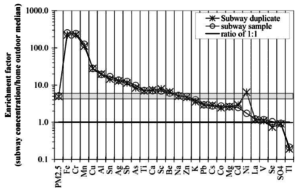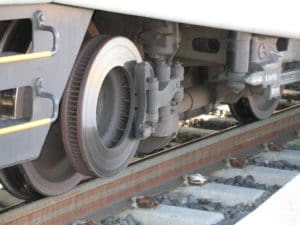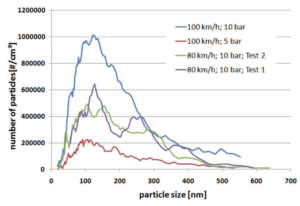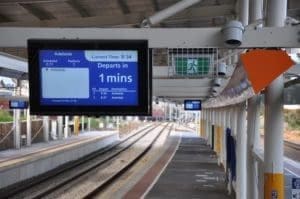WHAT IS RAILWAY DUST
Railway dust, or industrial fallout, is the fine metal particulates produced when metal rubs against metal. In fact, the friction between wheels and rails, the panto-graph and power line, or brake pads and a rotors are good example of this.
In this article we will focus on railway dust produced by brake dust. The graph below shows concentrations at above normal levels in the NYC subway system for a range of metal types.

WHAT IS BRAKE DUST?
While standing on a train platform, you’ve probably caught a wiff of an odd burnt odor wafting up from under the train. That smell is the trains break pads girding and producing microscopic dust particles. Just like your car, a train uses brake pads to slow itself. Even modern high speed electric trains with regenerative breaking systems rely on the friction of a brake pad to come to a complete stop.
As a consequence to the high pressure placed on them, modern brake pads are complex compounds. They consist of metals for heat dissipation, ceramics for durability and high heat resin’s that bind the elements together. The friction heat produced between the break pad and rotor form small dull grey particles or break dust.

WHAT DOES BRAKE DUST LOOK LIKE?
The easiest place to observe brake dust would be on your car. For example, you’ve probably noticed a pesky black powder sometimes covering your front wheels. Although slightly different to railway brake dust, this powder is visually the same.
HOW DOES BRAKE DUST IMPACT A DIGITAL DISPLAY?
Metal, ceramic and resin – the elements that make up break dust can cause the following issues for a digital display:
- Metal dust build up can cause short circuiting between components on a circuit board.
- Corrosive resins will eat away at copper traces and solder joins as well as make the removal of any particulates difficult.
- Ceramic dust build up can trap moisture and accelerate corrosion, or interfere with the heat dissipation of a part.
HOW CAN I PROTECT MY DIGITAL DISPLAY FROM RAILWAY DUST?
Digital displays or Passenger Information Displays (PID’s) are often located in outdoor environments and require screens up to 10 times brighter than your TV at home. As a result, this extra brightness comes with a heat penalty. Brighter screens that are viewable outdoors produce a lot of heat. The standard way for PID manufacturers to handle this excess heat is to circulate air through the enclosure. The air filters will filter a lot of the larger particles (5 microns or larger), but require regular cleaning and struggle to stop the fine brake dust particles from entering the enclosure.
The following chart depicts break dust particles as tiny in size. In fact, they have been grouped around 0.1 micron but can also be 0.05 micron or smaller.

For further information about our rugged high bright digital display, please contact our sales team on +61 7 3868 4255 or sales@metrospec.com.au
MetroSpec is a Division of Metromatics. Learn more about us here.

